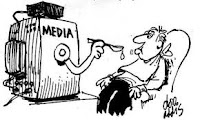Media Theories
It is suggested that the Uses and Gratification Theory has to fulfil one of the following needs when we choose a form of media:
- Identify- being able to recognise the product or person in front of you, role models that reflect similar values to yours, aspiration to be someone else.
- Educate- being able to squire information, knowledge and understanding.
- Entertain- what you are consuming should give you enjoyment and also some form of
- 'escapism' enabling us to forgot about our worries temporarily.
- Social Interaction'- the ability for media products to produce a topic on conversation between other people, sparks debates.
Reception Theory: Stuart Hall (1980)
Hall's 'encoding-decoding' model argued that media producers encode 'preferred meanings' into texts, but these texts may be 'read' by their audiences in a number of different ways:
- The Dominant- hegemonic position: a preferred reading that accepts the texts messages and the ideological assumptions behind the messages.
- The Negotiated Position- the reader accepts the texts ideological assumptions, but disagrees with the aspects of the messages, so negotiated the meaning to fit with their 'lived experiences'.
- The Oppositional Reading- the reader rejects both the overt message and its underlying ideological assumptions
Cultivation Theory: Gerbner
Exposure to television over long period of time cultivates standardized roles and behaviors. Gerbner used content analysis to analyse repeated media messages and values, then found that heavy users of TV were more likely, for example, to develop 'mean world syndrome'- a cynical, mistrusting attitude towards others- following prolonged exposure to high levels of TV violence.
'Mainstreaming'- common outlook on the world based on images and labels on TV.
Media Effects Theory: Bandura
The media can influence people directly- human values judgement and conduct can be altered directly by media modelling. Direct Influence. Can it lead to imitation? The media may influence directly or by social networks, so people can be influenced by media messages without being exposed to them. Different media have different effects. The 'new' media offers opportunities for self-directness.
Fandom Theory: Jenkins
Fans act as a 'textual poachers'- this is taking elements from media texts texts to create their own culture. The development of the 'new' media has accelerated 'participatory culture', in which audiences are active and creative participants rather than passive consumers. They create online communities, produce new creative forms, collaborate to solve problems, and shape the flow of media. This generates 'collective intelligence'. From this perspective, convergence is a culture process rather than a technological one. Jenkins prefers the term 'spreadable media' to terms such a 'viral', as the former emphasises the active, participatory element of the 'new' media.
End of Audience Theory: Shirky
In the 'old' media, centralised producers addressed atomised consumers; in the 'new' media, every consumer is now a producer. Traditional media producers would 'filter then publish'; as many 'new' media producers are not employees, they 'publish then filter'. These amateur producers have different motivations to those of professionals- they value autonomy, competence, membership and generosity. User- generated content creates emotional connection between people who care about something. This can generate a cognitive surplus.
- The 'old' media created a mass audience
- The 'new media provides a platform for people to provide valuer for each other

Comments
Post a Comment